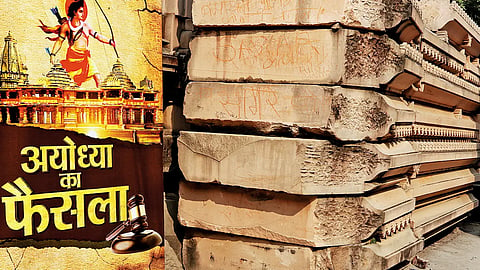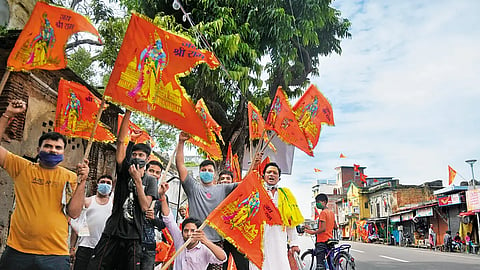AK Ramanujan perhaps overstepped by stating that no one reads the Ramayana for the first time. How many Indians have read the Ramayana even once? Have you? But Indians don’t need to read the epic in order to know about it. It’s a legend Indians of many generations and cultures have composed, adopted and performed for themselves to meet the ethos of their epoch. Called India’s “national heritage” by Rabindranath Tagore, the Ramayana is an ever-evolving tale in our collective memories. Even atheists may find it difficult to escape some formulations of the Ramayana, its episodes or characters, verses or metaphors, from influencing or shadowing their lives.
The Many Faces And Transformations Of Ram And His Story
If Tulsidas made Ram a self-effacing family man and king to be worshipped, the Ayodhya movement lent him a political identity. Tulsidas’s Ram was a stoic and gentle being. L.K. Advani’s Ram is an electoral warrior.
The Ramayana has also defined the nation’s geographical contours. At its heart, it is the story of an exile and a war, visualised and enacted on a landscape that stretches from the Himalayas to Rameswaram, making the modern Indian State nearly coterminous with the legends of the mighty Ikshvakus. Long before Ramanujan wrote about the three hundred Ramayanas, Tulsidas had said: “Ramayana sat koti apara (There are a hundred crore Ramayanas).”
The BJP’s narrative on Ayodhya is also a retelling, which, like any major retelling of the previous eras, has transformed the reception of the deity and psychology of his devotees. If Tulsidas made Ram a self-effacing family man and king to be worshipped and idolised in millions of households, the Ayodhya movement lent him a political identity. Tulsidas’s Ram was a stoic and gentle being. L.K. Advani’s Ram is an electoral warrior.
To know how the sudden and unlikely fusion of the two opposite identities mutated Indian families, consider the tale of a man born in a temple town of Uttar Pradesh. In the early 1960s, when he was a kid, his grandmother asked him to recite verses of the Ramcharitmanas, in lieu of which, she gave him a few paise. The boy soon nearly memorised the text and, with his father being the priest of a Hanuman temple, became a child devotee.
With the priest father suffering from multiple attacks of tuberculosis, the eldest of four sons began visualising himself as the family’s maryada purushottam. As it went, the self-effacing man was married off to a woman for whom self-abnegation was a supreme ideal.
The priestly family had close ties with Muslim neighbours. From the milkman, the tailor to the bangle seller, the family was close to Fakhruddin, Shahabuddin, Mehfuz and many more. The ideal of Ram Rajya defined the family. Then Advani’s chariot arrived, and the benign man suddenly started feeling threatened by the community he had lived with since childhood. This is the tale of my own family. But it can mirror thousands of families across India.
Do the saffron warriors know how the deity is portrayed in our scriptures? Ram is maryada purushottam, the supreme man with absolute adherence to ethics, the Lord of the greatest attainable kingdom. “Daihik, daivik, bhautik tapa/ Ram Rajya nahin kahuhi vyapa (In Ram Rajya, every citizen is free from all fears and illnesses).
ALSO READ: Lesson On Environment From Ramayan
But maryada demands sacrifices, leaving your inner desires unfulfilled and pushing you into a perpetual dilemma. Valmiki’s Ram is aware that kshatriya dharma is “fundamentally unrighteous”. He even tells Lakshman that it “attracts the base, the cruel, the greedy and those inclined to be wicked”. But he will never waver from the path, his inner self always limited by the kingly code.
Ram is cognisant of the injustice of which he becomes both a victim and a carrier. He submits to Dasharath and withdraws to the forest, but he can discern the wrong his father has committed, and speaks about the “disaster that has befallen me as a result of the king’s infatuation”. “Even an ignorant man would not renounce his son for the sake of a beautiful woman… He who abandons wealth and dharma and chases after pleasure shall soon destroy himself, like Dasarath did,” he tells Lakshman.

Why does he then obey his father? Why does he not rebel? Because he follows maryada.
When he arrives in Dandakaranya during the exile and promises sages to protect them from demons, Sita warns him that it is not a kshatriya’s battlefield. Cautioning him that “the mind is perverted by extreme proximity to weapons”, she advises him to “respect the code of behaviour of the world we now inhabit” and to “enjoy the beauties of the forest with a pure mind”.
But Ram knows of only one code. “I could more easily give up my life or renounce you or Lakshman than break a promise,” he tells her.
Thus, Ram is a tragic character. A tragic son and a tragic husband. In the Valmiki Ramayana, when he asks his brothers to banish Sita, he’s in profound grief for having to abandon his wife. But as a king, he can’t think of any other way to quell the discomfort his citizens have about her.
Worship him, assess him, criticise him, but Ram is perhaps the most common name in India, both of people and places, even occurring as prefixes or suffixes. Many Indians may find it difficult to spend a day without uttering the word. In fact, much before he arrived as Vishnu’s seventh avatar, his predecessor avatar Parashuram already had him as the suffix in his name. His leela has travelled to many countries. Ayutthaya, the capital of several kings in Thailand for centuries, was named after Ayodhya, with many kings even assuming the name of Ram.
But the legend is not about him alone. It’s about those characters that illuminate him, with whom he forms epic bonds. It’s the tale of a younger brother who will place the sandals of the elder one on the throne and run the kingdom in his name. It’s about another younger brother who will leave the palace behind and follow the elder one to exile. It’s about a wife left behind, the lonely woman in the palace. It’s about a wife abandoned on the altar of kingly code. It’s about Hanuman, who enters the tale of the exiled princes midway, and goes on to become a revered standalone deity. And then, it’s about the great scholar Ravan, who can’t overcome his one fatal flaw—the desire for a woman—that causes his downfall.

It is an epic family drama, about people constrained by the vows they consider sacrosanct and inviolable, about people chasing impossible ideals, often being aware that it would only bring them doom. One doesn’t need to approach it as a scripture; many generations have cherished it as a great text of world literature. The richness of the tale, the loftiness of its morals and the tragic fall of its characters fascinate and intimidate.
ALSO READ: In The Land Of Asurs Where God Is Formless
The mythology gets enriched with a myriad of retellings or performances in several languages. Valmiki may be the Aadi Kavi and his Ramayana the Aadi Kavya, but his successors comprehensively transformed the tale. When Tulsidas brings Ram into Avadh, he removes the two most objectionable episodes in the narrative—the banishment of Sita and the killing of the Shudra Shambuka. He also dilutes the agnipariksha episode. One can say it marks Tulsidas’s dissent against his predecessors for portraying the Lord in uncharitable shades. Perhaps, that explains why Ramcharitmanas became the household text across north India.
But not everyone is Tulsidas. In another marvellous Sanskrit text aptly named Adbhut Ramayan, Sita is not only the daughter of Ravan’s wife Mandodari, she also eventually kills Ravan. There are also great instances of inter-textuality, with several Ramayanas in conversation, most evident in an extraordinary episode of Adhyatm Ramayana. When Ram asks Sita to not accompany him and stay behind in Ayodhya, she bluntly says: “I have heard various versions of Ramayanas, recited by various scholars. In which of these, do you find Ram going to the forest without Sita? In none.”
How many scriptures and deities can allow such flexibility and malleability? Such are the interpolations that many episodes, which may not have any textual basis, remain in our collective memory as inalienable sequences of the Ramayana. The widely prevailing metaphor of Lakshman Rekha doesn’t appear at all in Valmiki’s or Kamban’s text, and has only an oblique and brief mention in Tulsidas’s version, not when Sita is about to be abducted, but in an altogether different episode. How does the metaphor come into vogue? One can leave such questions to the researchers, allowing people to enjoy their individual interpretations.
ALSO READ: Asura: The Last Words Uttered By Ravan
Even smaller communities fashion their own Ram. When local priests prohibited Dalits from chanting the name of Ram in some areas of central Chhattisgarh in the late 19th century, the untouchables, as a mark of rebellion, tattooed the deity’s name on their private parts.
It’s not limited to Hindu communities. Last year, in a Buddhist household in Sissu village of Lahaul, I found a carefully preserved Urdu translation of Ramcharitmanas. The book, printed at least 150 years ago, had yellowed, its paper turned fragile. The Buddhist family had been reading a Hindu text in Urdu.

And where’s the abode of Ram? He lives in the vast geography he traversed as an exiled prince, and later as a king. Each place is a pilgrimage. Ayodhya may be a political rallying point, but there are Chitrakoot, Dandakaranya, Nashik, Rameswaram—besides Hinglaj, a small town in Balochistan, Pakistan, where Ram is said to have arrived to expiate for the sin of killing Ravan.
The insistence on Ayodhya is a crude mechanisation that disregards the legend. Commenting on the BJP’s claim on Ayodhya, Diana L. Eck wrote, in India: A Sacred Geography: “How very dissonant the pledge to reclaim ‘this very place’ sounded, given India’s long history of multiplying the sacred in a complex landscape, rich with a sense of plenitude.”
The Ayodhya movement, which made Muslims an inevitable other of Hindus, was in absolute dissonance with all the forms of Ram we have known. Ram is a great unifier. India has had a history of tussle and violence between the Shaivites and the Vaishnavites. Tulsidas’s Ram emphatically declares: “Shiv drohi mam daas kahava/So nar mohi sapnehu nahin pava (Those who go against Shiva and call themselves my devotee, Can’t find me even in their dreams).”
The Ram Mandir movement damaged the glorious tradition. Here’s an untold story of the Babri demolition, narrated to this reporter by three different eyewitnesses. As the crowd climbed up the domes of the mosque on December 6, 1992, the Ram Lalla deity that was placed under a tomb was also razed to the ground. The idols that had appeared in December 1949 disappeared in another December decades later.
In October 2016, I raised the issue in a recorded interview with the Bajrang Dal founder and then BJP MP Vinay Katiyar, who was among the prime actors on that day. About the demolition, he said: “Dhai ghante ke andar sab khatm ho gaya. Ek-ek int chali gayi…lakhon log thhe.. ek-ek mutthi lekar chale gaye. Bacha kya wahan? Kuch nahin bacha. (Everything was over within two-and-a-half hours. Every single brick was removed… there were lakhs of people… they carried a handful (of debris) each. What remained there? Nothing).”
That perhaps adds to the tragic character of the epic. The avatar, who took birth to protect sanatan dharma, could not escape a Hindu mob’s wrath.
(This appeared in the print edition as "The Epic, Plus Ça Change...")